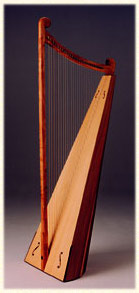|
|
 |
|
Early Harps
Here are photos and brief descriptions of some of the types of harp that have been prominent in musical history.
|
|
|

|
Gothic style Renaissance Harp
These small harps were the standard harp throughout Europe in the late Middle Ages and
the Renaissance period in music history. They were strung with gut strings at a much lower tension than we are accustomed to today. Earlier models had 19 to 22 strings, later harps
were larger and had 26 to 30 strings. They were tuned diatonically, half steps usually accomplished by pressing the string against the neck near the top. Current scholarship
tells us that these harps almost always employed brays, small L shaped pegs that touch the string very lightly near the soundboard. The effect is a nasal rattling sound
similar to a crumhorn or regal organ. The soundbox was generally hollowed from a plank of hardwood, giving the harp a distinctive plucked sound that differed from the
lute, an instrument it often played with in consort.
|
|
|
Italian Arpa Doppia
This three-rank Italian harp of the late Renaissance or
early Baroque period had 26 chromatic strings in the central row, with 24 trebles on the right, and 25 basses on the left. This gives a two octave diatonic duplication in the middle range
of the harp. The center row of strings supplies all of the half steps, including the enharmonic notes. The range descends to GG (two octaves below middle C). The soundbox is built up of
hardwood staves, and the soundboard is maple, as were all but the latest examples.
|

|
|
|

|
Early Spanish Harps
The Spanish single rank and cross-strung harps generally had 29 diatonic strings,
lowest note C, two octaves below middle C. The chromatic strings intersected, or went between, the diatonic strings, forming an X. In this way, all chromatic and diatonic
strings were accessible to both hands at any point on the harp. The soundboard is very guitar-like, spruce with cross bracing, producing a marvelous sound.
The single rank harp could be fretted against the neck for half steps.
|
|
|
Wire strung harps
Many would say that the
ancient Irish harps are the predecessors of our current lever harps in spirit, if not in technical features. These instruments were wire strung (brass, iron, silver, or gold) often
with the soundboxes carved from a single piece of willow (bog wood).
|

|
|
|

|
|
Italian Double-Row Harp
This harp is housed in the Muse√© Instrumental du Conservatoire, Royal de Musique, Brussels, Belgium.¬
It has a carved soundboard of maple and a five-staved back made of walnut with 52 chromatic notes, ranging from C to c''', all gut strings and
without brays.¬ This harp has been well studied and there is some controversy about its having been a triple row harp. It stands 156 cm tall.
This harp is attributed to Martino Kaiser, Venice, 1675.¬ One of the few extant harps with a label.
|
|
|
|

|
|
Wartburg Single-Row Harp
(circa 1350-1450)
This instrument was acquired during the middle of the 19th century for the art collection
of the Wartburg Museum, Eisenach, Germany. It purportedly belonged to Oswald von Wolkenstein, who lived in Tyrol from 1377-1445. The original is beautifully
inlayed with Certosinia-work. Some believe the inlay was added after the harp was built. It has 26 gut strings from F to c''', and a full set of brays. It is a
'carved-body' type and made of maple. It stands at 109 cm high.
|
|
|
|
|

